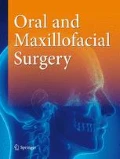Zusammenfassung
Kultivierte Epithelzellen werden regelmäßig für In-vitro-Studien benutzt. Gingivakeratinozyten werden hierfür üblicherweise in Kulturgefäßen gezüchtet, auf deren Boden sie adhärent anwachsen. Die eine (basale) seite des Epithels ist damit nicht getrennt zugänglich. Um an kultivierten Gingivakeratinozyten Barrierefunktion und Transportvorgänge untersuchen zu können, ähnlich wie sie dem Epithel in der Mundhöhle in vivo zukommen, ist die Anzüchtung auf einem permeablen Trägermaterial notwendig. Es wurden auf verschiedenen permeablen Membranen aus Polykarbonat verschiedener Porengröße und Nylon je 6 Primärkulturen als Explantate und je 6 Sekundärkulturen als Einzelzellsuspensionen angelegt. Es wurde jeweils noch 1 Kontrollkultur auf Petrischalen direkt angesetzt. Die Zellen wurden für 14 Tage kultiviert und beobachtet. Danach wurden die Kulturen fixiert und histologisch aufgearbeitet. Das konfluente Wachstum in der Primärkultur war auf allen Unterlagen sicher zu erzielen. In Sekundärkultur war es möglich, auf Polykarbonat aller Porengröße konfluente Zellrasen zu erhalten, auf Nylon wurden keine zusammemhängenden Keratinozytenverbände gefunden. Dadurch können Gingivakeratinozyten in einem In-vitro-Modell zur Untersuchung der Barriere-und Transportfunktion eingesetzt werden.
Summary
Cultured epithelial cells are used in in vitro studies. Gingival keratinocytes are usually grown adherent to the floor of the culture dish, whereby the basal side of the epithelium can not be approached. To be able to study barrier function and transepithelial transport processes the gingival keratinocytes were seeded on different permeable membranes as support material. Six primary keratinocyte cultures each using the explant technique were established on polycarbonate membranes with pore sizes 2–8 mm and on nylon. Secondary cultures were established accordingly as single-cell suspension. Primary cultures formed confluent epithelial cultures on all membranes tested, whereas in secondary culture confluent gingival keratinocyte epithelia were found on the polycarbonate membranes. only. Thus, gingival keratinocytes can be used to study barrier and transport functions in an in-vitro model.
Literatur
Barnetson R, Gawkrodger D (1995) Überempfindlichkeit — Typ IV Reaktion, 22. Kapitel. In: Roitt IM, Brostoff J, Male DK (Hrsg): Kurzes Lehrbuch der Immunologie, 3 Aufl. Theime, Stuttgart New York, S. 210
Lauer G, Minuth WW (1988) Apico-basal osmotic gradient induces transcytosis in cultured renal collecting duct epithelium. J Membr Biol 101: 93–101.
Lauer G, Otten J-E (1992) Kultivierte Mundschleimhaut — ein differenzierter Gewebeverband zur intraoralen Defektdeckung. Dtsch Zahnarztl Z 47:857–859
Lauer G (1994) Autografting of feeder-cell free cultured gingival epithelium — Method and clinical application. J Craniomaxillofac Surg 22: 18–22.
Lauer G, Axmann S, Otten J-E (1995) Humane Gingivakeratinozyten auf verschieden strukturierten Titanoberflächen. Dtsch z Mund Kiefer Gesichtschir 19: 146–149.
Leigh IM (1995) Reepithelialisation of wounds. II. Morphology and physiology. In: Altmeyer P, Hoffmann K, Gammal S el, Hutchinson J (eds) Wound healing and skin physiology. Springer, Berlin Heidelberg New York, S 45
Ouhayoun JP, Gosselin F, Forest N, Winter S, Franke WW (1985) Cytokeratin patterns of human oral epithelia: differences in cytokeratin synthesis in gingival epithelium and adjacent alveolar mucosa. Differentiation 30: 123–129.
Papapanou PN, Sandros J, Lindberg K, Duncan MJ, Niederman R, Nannmark U (1994) Porphyromonas gingivalis may multiply and advance within stratified human junctional epithelium in vitro. J Periodontal Res 29: 374–375
Sandros J, Papapanou PN, Nannmark U, Dahlén G (1994) Porphyromonas gingivalis invades human pocket epithelium in vitro. J Periodontal Res 29: 62–69.
Schroeder HE (1987) Gingivale Mundschleimhaut — Orale Strukturbiologie, 3. Aufl. Thieme, Stuttgart New York, S 355
Author information
Authors and Affiliations
Additional information
Die Untersuchungen wurden aus Mitteln des BMBF (Förderkennzeichen 01KI9314/6) unterstützt.
Rights and permissions
About this article
Cite this article
Lauer, G., Otten, J.E. Kultivierung von Gingivakeratinozyten auf permeablen Membranen: Simulation der Funktion des Mundhöhlenepithels. Mund Kiefer GesichtsChir 1, 35–38 (1997). https://doi.org/10.1007/BF03043505
Published:
Issue Date:
DOI: https://doi.org/10.1007/BF03043505

